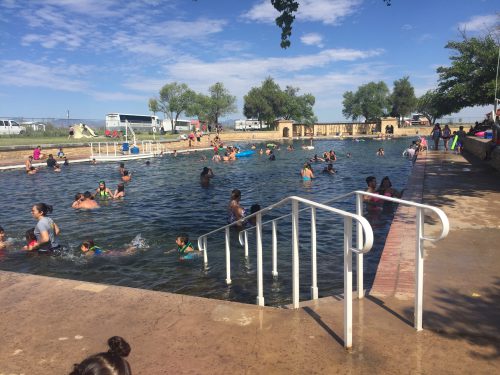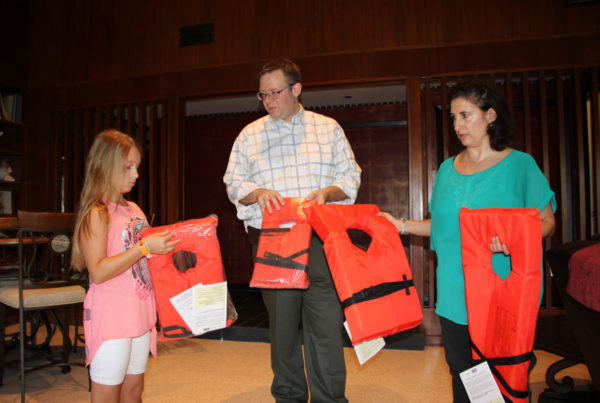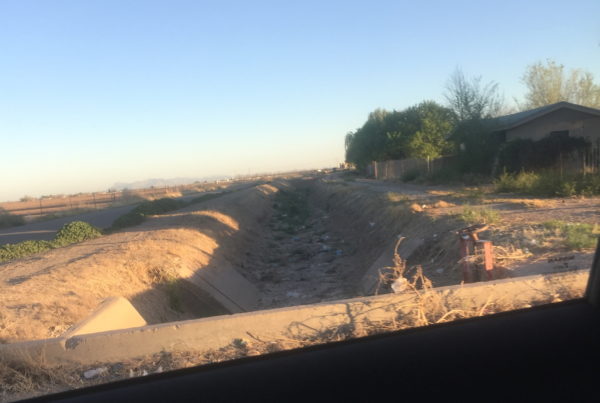Balmorhea State Park is home to the largest spring-fed swimming pool in the world. Each day, the San Solomon Springs pumps 15 million gallons of fresh water through the pool. But what used to be a hidden gem in the arid desert, has been discovered. Over the last several years, more and more people are making the trek to this west Texas park.
Carolyn Rose, the park’s superintendent, believes that social media’s behind the onslaught of new visitors. “Somehow, this park got discovered,” she says. “People come from a long way. They put it on their bucket list and they want to come swim in the springs.”
One recent steamy Saturday morning, Rose is greeting cars as they line up at the entrance. She says this isn’t uncommon. In almost 10 years, the number of annual park visitors has jumped 127 percent: the park saw 163,000 visitors last year, up from about 72,000 visitors in 2008, according to the Texas Parks and Wildlife Department.
Rose says the swell in visitors is having a negative impact on the park’s natural and cultural resources. In May, Balmorhea began limiting visitor numbers to 1,300 a day. A thousand people are allowed entry in the morning, and 300 more are given tickets to enter the park at 3 p.m. Weekends have gotten so busy that the park now updates its capacity on Facebook and Twitter.
Ashley Duvall travelled to Balmorhea from Midland. She’d been checking the park’s social media status updates, but that didn’t prevent her and her friends from waiting an hour and 15 minutes to gain entry to the pool. Storms the night before had made the park’s computer system slower than usual. “It has been a long wait, I’m not going to lie,” she says. She even unpacked her lounge chair, sitting while she waits.
While swimming in the pool, in and of itself, doesn’t have a negative impact on the park’s natural resources, it’s the other things that visitors do that are creating problems. According to Superintendent Carolyn Rose, visitors have strung up hammocks on the columns of historic pagodas built in the 1930s, dumped charcoal on the roots of cottonwood trees, and caught the park’s rare and protected Headwater catfish in ziplock bags. Children and dogs are let loose to splash in the park’s canal system, which is protected habitat for the park’s two species of endangered fish: the Pecos gambusia and the Comanche Springs pupfish.
Wesley Pool – yes, that’s his real last name – stands by the pool’s edge, a dripping wet suit pulled halfway down his chest. He’s been traveling to Balmorhea from his home in Clovis, New Mexico for the last 10 years, to scuba dive in the clear blue waters. He says he likes to interact with the fish he sees at the bottom.
“You can take crackers in a sandwich bag and crumble them up, and when you get down to the bottom you open it up. You do a circle with the crackers and the minnows just go nuts,” he says. “I mean it’s a feeding frenzy. They just engulf people. That’s fun to do.”
Superintendent Rose warns of the negative impact this could have: “People are feeding, constantly; they’re feeding the fishes and turtles. And primarily, it seems like the thing they like to feed them is white bread. And y’know, white bread isn’t even really that healthy for human beings.”
But there are plenty of people like Pool who simply aren’t aware that what they’re doing is wrong. That’s why Texas Parks and Wildlife plans to make educational outreach a priority. Once the peak summer months are over, its goal is to educate the public about preserving the park. Educational initiatives have been key to limiting human impact at other natural pools in the state.
Wayne Simmons is the Aquatic Program Manager for the City of Austin’s Parks and Recreation Department. He says that Barton Springs – another famous Texas watering hole – can receive anywhere from 2,000 to 10,000 guests a day. But because of its educational initiatives, he doesn’t see many of the same problems that are taking place at Balmorhea.
“When [visitors] see the educational exhibits that we have, and they learn, their eyes open up really wide and it’s like ‘Oh okay.’ The light bulb comes on,” Simmons says .
While there are similarities, Barton Springs has an army of staff, volunteers, and public support. In west Texas, a statewide hiring freeze has left the Balmorhea State Park short four employees all summer long, while public interest keeps rising. So, for now, Rose is focused on what she can do – and that’s controlling the number of people that enter.

















